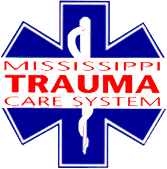
About the Trauma Care System

Mississippi's Trauma Care System, established in 1998 by the Mississippi Legislature, became the first statewide trauma system in the United States to mandate hospital participation in 2008. Section 41-59-5 (5), Mississippi Code of 1972, as amended, establishes the Mississippi State Department of Health (MSDH) as the lead agency in statewide Trauma Care System development.
MSDH bears responsibility for implementing and managing the statewide Trauma Care System. This responsibility includes developing and administering the statewide Trauma Care System Plan and Trauma Care System Rules and Regulations. These documents provide for the standards and processes involved in Trauma Care System implementation. Elements of the Trauma Care System include funding, performance improvement, data collection, education and prevention programs, inter-facility transfer agreement(s), designation of trauma centers, trauma team activation and EMS field destination guidelines.
Level I Trauma Centers
Level I facilities are tertiary care facilities located at the hub of the state’s geographic regions (central, north and south). These facilities contribute substantially to statewide trauma system planning, provide trauma education, carry out trauma research and offer trauma prevention programs. Ideally, these facilities provide total care of the trauma patient for every aspect of injury through rehabilitation. Required resources include:
- Surgical Residency Program
- Neurological Surgery
- Orthopedic Surgery
- General Surgery
- Anesthesia
- Post Anesthesia Care Unit (PACU)
- Intensive Care Unit (ICU)
- Emergency Department
Level II Trauma Centers
Level II facilities are acute care facilities with the commitment, resources and specialties to provide sophisticated trauma care. Required resources include:
- Neurological Surgery
- Orthopedic Surgery
- General Surgery
- Anesthesia
- Post Anesthesia Care Unit (PACU)
- Intensive Care Unit (ICU)
- Emergency Department
Level III Trauma Centers
Level III facilities are acute care facilities with the commitment, resources and specialties to provide initial resuscitation of trauma patients. Generally, these facilities provide initial resuscitation of trauma patients and immediate operative interventions to control hemorrhage, and to assure maximal stabilization prior to referral to a higher level of care facility. However, many trauma patients may remain at the Level III facility, because their condition does not warrant transfer to a higher-level of care facility. The decision to transfer the trauma patient rests with the attending physician. These facilities will collaborate with other trauma centers and develop transfer protocols to ensure a well-defined transfer sequence. Required resources include:
- Orthopedic Surgery
- General Surgery
- Anesthesia
- Post Anesthesia Care Unit (PACU)
- Intensive Care Unit (ICU)
- Emergency Department
Level IV Trauma Centers
Level IV facilities are generally licensed, small, rural hospitals with the commitment to resuscitate and transfer trauma patients as appropriate to higher-level facilities. These facilities maybe staffed by either a physician or advanced practice providers.
Find this page at http://msdh.ms.gov/msdhsite/index.cfm/index.cfm